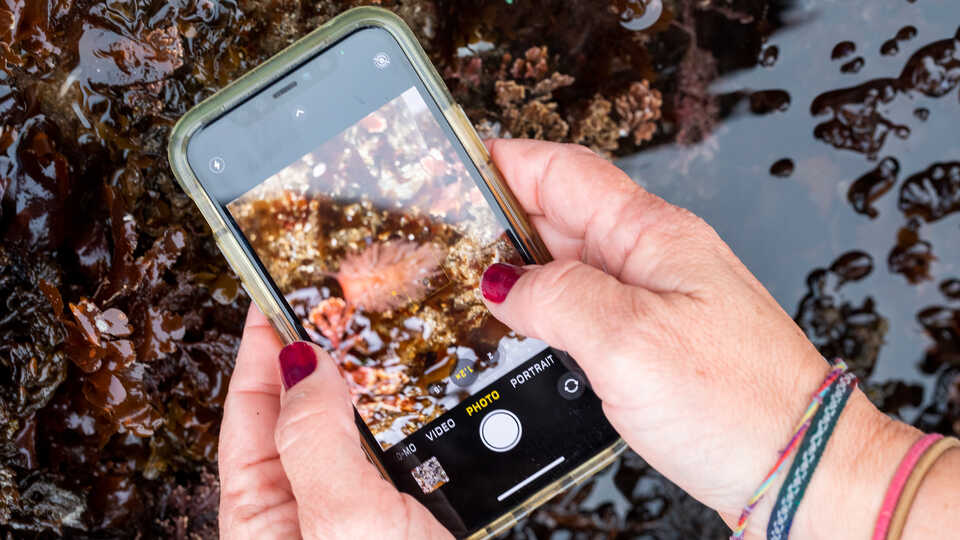The Academy's Center for Biodiversity and Community Science connects people to nature and to each other through the collection of biodiversity data for science and management.

iNaturalist is a community science platform that enables anyone to make observations of plants, animals, and fungi, learn about the organisms they see, and contribute to biodiversity databases like the Global Biodiversity Information Facility (GBIF). This page contains videos and resources to help you navigate and use iNaturalist effectively to ensure that your observations are as useful as possible for scientists.
Getting started
Create an iNaturalist account and check your settings:
- Make sure your location settings are on in both your device settings and camera app settings when using the iNaturalist app. We need to know when and where a biodiversity observation was made in order for it to be useful!
- Make sure your account license settings are set so that your observations can be used by scientists. Go to iNaturalist Account Settings > Content & Display > Licensing and check that your default observation license is set to CC0, CC-BY, or CC-BY-NC. You have the option of licensing your photos and sound recordings separately if you prefer to retain more control over them.
How to make a useful observation

Take multiple good photos:
- The most important thing is that the organism is clear and in focus—not too dark or washed-out or among competing objects or species.
- Crop your photo before uploading it to exclude other objects that may be distracting. This gives the computer vision model the best chance of accurately identifying your species.
- Photograph your subject from multiple angles and with different levels of detail. For example, for a plant, you can take one zoomed-out photo of the whole organism from the base to the top, one close-up photo that focuses on the pattern and shape of the leaves, and another photo of any other interesting structures that may be present. More photos make it more likely that your observations can be identified accurately and may help researchers use your observations in different ways. For example, if you include a photo of a bud, flower, or fruit in a plant observation, researchers can use it to track seasonal changes in plants.
- Be aware of glare or reflections from the water surface if you are photographing species in tidepools or from a dock or boat.
- Step up your smartphone photography skills: Check out this blog for tips on improving your tidepool photography, and download this guide from BC Parks for how to photograph a variety of different species.
Photo credit: F. Navalcarnero

Upload observations the smart way:
- Choose the clearest, most representative photo as the first (main) photo for your observation. This is the photo that iNaturalist’s computer vision model will use to try and identify the species. The other photos will help others in the iNaturalist community either confirm or correct the initial species identification from the model.
- Instead of leaving an identification as “unknown,” type in the broad category of the organism if you know it. If the iNaturalist computer vision model provides an inaccurate identification or you’re not even sure what you’re observing, give the organism’s category your best guess.For example, if you observe an unknown mushroom, you can identify it as “Fungi,” or if you take a photo of an unknown bug, you can identify it as “Insects.” This allows other iNaturalist users to find your observation and help identify it.
- The iNaturalist computer vision model cannot identify sound recordings. If you are uploading a sound recording (a bird’s song or a frog’s vocalization, for example) and do not know the species, type in and select the broad category, such as “Birds” or “Frogs and Toads.”
Help identify observations and make them usable for research
After an observation has been recorded in iNaturalist, the species identification needs to be made and confirmed in order for the observation to be useful for scientists. The gold standard is “Research Grade” observations: These are high-quality, confirmed observations that become part of global biodiversity databases.
- You can help identify observations made by other iNaturalist users by using the “Identify” tool to find all observations that need identifying. You can also click on an individual observation to identify it. New observations are being made all the time, so we always need more identifiers!
- Even if you are new to learning about the species in your area, you can help sort “unknown” observations into broad categories like “Birds,” “Plants,”and “Snails and Slugs” so that others with more experience can easily find and identify them.
- If someone suggests an identification on your observation, don’t “agree” with it unless you’re absolutely sure it’s correct. Otherwise, observations may become “Research Grade” mistakenly.


